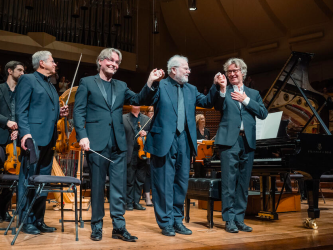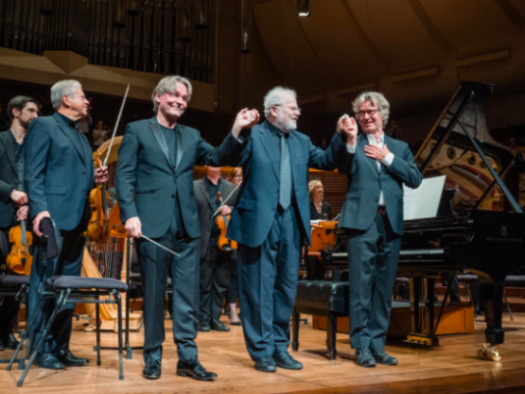 United States Brahms, Hillborg, Beethoven: Emanuel Ax (piano), San Francisco Symphony / Esa-Pekka Salonen (conductor). Davies Symphony Hall, San Francisco, 13.10.2023. (HS)
United States Brahms, Hillborg, Beethoven: Emanuel Ax (piano), San Francisco Symphony / Esa-Pekka Salonen (conductor). Davies Symphony Hall, San Francisco, 13.10.2023. (HS)

Brahms – Variations on a Theme by Joseph Haydn
Anders Hillborg – Piano Concerto No.2 ‘The MAX Concerto’ (San Francisco Symphony Commission, world premiere)
Beethoven – Symphony No.2 in D major
Anders Hillborg’s new piano concerto, written for Emanuel Ax, lit up Davies Symphony Hall with joyful insouciance and effortless creativity in its second performance on Friday evening. It was the highlight of a concert brimming with energetic music-making of the highest order.
‘The MAX Concerto’ – nicknamed by the Swedish composer to celebrate the eminent American pianist – burst out of the starting gate with grand arpeggios that harkened back to Beethoven and Grieg, then wended its way through fields of hazy chords, outbursts of pungent dissonance, devilishly complex piano finger-busters and a welcome range of dynamics and tempos. All of it shone with the exuberance and matter-of-fact virtuosity that have long characterized this pianist.
The piece was commissioned by San Francisco Symphony, and underwritten by Napa Valley vintner John Kongsgaard, a generous supporter of classical composers and performers. The maker of some of the best Chardonnay in California, he runs a high-level chamber music series in Napa and hosts great classical musicians at his home on Atlas Peak. Hillborg’s Kongsgaard Variations for string quartet is one of the composer’s best-known pieces. Kongsgaard was beaming as the new work got an enthusiastic standing ovation.
The response was well-deserved. For 25 minutes in a single movement, neither the orchestra nor conductor Esa-Pekka Salonen ever lagged, even when the tempo slowed and the dynamics ebbed into softness. Hillborg’s harmonies and fresh orchestration created moments of sheer beauty, and there was wit too. Portions of it were played at the very top range of the piano emulating a toy piano, and there was a delightful contrapuntal section that winked at Baroque dances.
Although the orchestral colors and busy-ness might have made a delightful piece without the piano, every phrase dovetailed with whatever the piano was up to. Unlike most concertos, which figuratively pit the orchestra against the soloist, this one had a different aim. It got the entire team on the same side, encouraging each other at some points, soothing with achingly supple music at other times and revving up to big climaxes.
Hillborg designated nine different parts to the piece. The titles included ‘Grand Piano’, ‘Mists’, ‘Toy Piano’, ‘Chorales and Echo Chamber’, ‘Soft Piano’ and ‘Ascending Piano’, but artful transitions deftly tied it all together into a sort of stream of consciousness. In the middle of the proceedings, Ax spun out an extensive cadenza with bravado.
Symphony audiences got a taste of Hillborg in the opening night concert (see review). His cheeky Rap Notes, featuring two hip-hop artists and a coloratura soprano, stole the show in a program that included pieces by Mahler, Ravel and Richard Strauss.
This program opened with Brahms’s Variations on a Theme by Joseph Haydn, an apt choice in several aspects. Brahms also refashioned a familiar form and did it in a similar way, going well beyond the usual adding-on of decorations, changing of tempos and major-minor tonalities. His version of the classical theme-and-variations almost anticipated jazz by creating whole new melodies and gestures out of the original theme, keeping only the bass lines and chords. It even had a finale that tried out a whole range of short variations before bringing the theme back one more time.
Salonen’s Brahms kept the accelerator pedal down, never letting stately tempos lag, infusing energy and vivid colors into every variation. When the theme made its triumphant return at the end, it felt like an old friend coming home from extensive traveling.
The same sort of crisp attention to detail made Beethoven’s Symphony No.2 come to life with a sort of freewheeling flair. Rhythms were punchy. Once past the Adagio in the opening section, the first movement jumped into high gear for the Allegro. Even the lovely Larghetto moved along at a graceful pace. In the finale, contrasts between the rhythmic vitality of the main theme and the sweet cello song led to a vivid finish as it all came together.
Harvey Steiman
